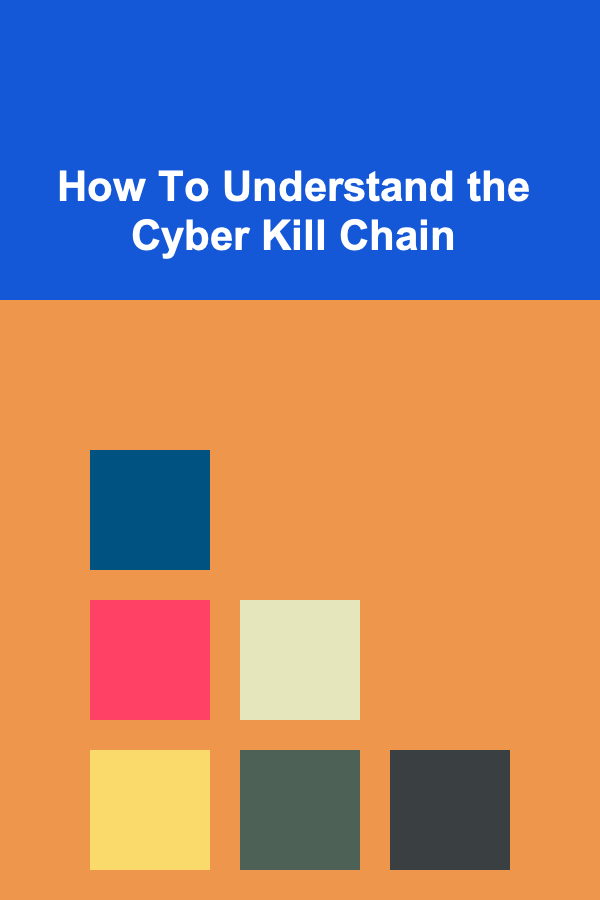
How To Understand the Cyber Kill Chain
ebook include PDF & Audio bundle (Micro Guide)
$12.99$5.99
Limited Time Offer! Order within the next:

The cyber kill chain is a concept used in cybersecurity to describe the stages of a cyberattack. Originating from military theory, the kill chain framework helps organizations identify and mitigate cyber threats by understanding each stage an attacker goes through. This knowledge can lead to more effective defense mechanisms and a proactive approach to cybersecurity.
In this article, we'll break down the cyber kill chain, explain its significance, and explore how it can be used by organizations to improve their security posture.
What is the Cyber Kill Chain?
The cyber kill chain is a model that outlines the various stages an attacker goes through when targeting a network or system. It was first developed by Lockheed Martin in 2011 as part of its Cyber Kill Chain framework, which was designed to improve the detection, prevention, and response to cyber threats. The concept is inspired by the military kill chain, where a series of steps are followed to accomplish a mission.
In the context of cyber threats, the kill chain helps organizations identify the phases of an attack. These phases can range from initial reconnaissance to the final goal of exploiting a vulnerability. By understanding the kill chain, defenders can better detect, disrupt, or prevent attacks at various stages.
The cyber kill chain is typically broken down into seven stages:
- Reconnaissance
- Weaponization
- Delivery
- Exploitation
- Installation
- Command and Control (C2)
- Actions on Objectives
Reconnaissance: Gathering Information
The first step in the cyber kill chain is reconnaissance, where the attacker gathers information about their target. During this phase, attackers collect data that could help them exploit vulnerabilities in the target system. This could involve passive methods such as searching publicly available information, or more active methods like scanning the network to identify weaknesses.
Reconnaissance is an essential step, as it lays the groundwork for the rest of the attack. Attackers may use tools like social engineering, domain analysis, or search engine queries to collect details about the organization's infrastructure, employees, and security measures.
For defenders, detecting reconnaissance activities can be challenging, but monitoring network traffic and suspicious external requests can offer some insight into this stage.
Weaponization: Preparing the Attack
Once enough information has been gathered, the next step is weaponization. In this stage, attackers create the tools that will be used to exploit the vulnerabilities identified during reconnaissance. Weaponization often involves creating malware, viruses, or other forms of malicious code designed to compromise the target.
The attacker may combine an exploit with a piece of malware, such as a remote access trojan (RAT), or craft a spear-phishing email with a malicious attachment. This phase could involve writing custom scripts, creating payloads, and preparing exploits for specific software or vulnerabilities within the system.
From a defense perspective, it's essential to keep software up to date and implement endpoint security measures to detect malicious code before it spreads further.
Delivery: Getting the Malicious Payload to the Target
Delivery is the stage where the attacker attempts to send the malicious payload to the target. This could be through various vectors such as phishing emails, USB drives, or compromised websites. The attacker's goal is to deliver the weaponized malware or exploit code to the victim's system.
At this point, the attacker is relying on the victim to open an infected attachment, click on a link, or execute a malicious script. In the case of spear-phishing, the attacker may target specific individuals within the organization, such as employees with access to sensitive data, using social engineering techniques.
Defense mechanisms like email filtering, web security, and endpoint protection are crucial in identifying and blocking delivery attempts before they reach their intended target.
Exploitation: Triggering the Attack
Once the malicious payload has been delivered, the next step is exploitation. In this phase, the attacker takes advantage of a vulnerability in the system to execute the payload. This could involve exploiting software bugs, weak passwords, or misconfigurations to gain unauthorized access to the target system.
Exploitation is the phase where the attacker's access is solidified. The attacker could take control of a system, escalate privileges, or steal sensitive information. For example, attackers may use a vulnerability in the operating system or application software to gain a foothold on the target system.
To defend against exploitation, organizations must employ strategies such as regular patching, vulnerability management, and access control to reduce the chances of a successful exploit.
Installation: Establishing a Foothold
Once the attacker has successfully exploited the system, the next step is installation. In this stage, the attacker installs malware or other malicious software that provides persistent access to the compromised system. This could involve installing rootkits, backdoors, or other types of malware that allow the attacker to maintain control over the system.
The goal of installation is to ensure that the attacker can continue to access the system even after initial detection. At this point, the attacker may disable security software, erase logs, or take other measures to cover their tracks.
From a defense perspective, detection and response mechanisms such as network monitoring, intrusion detection systems (IDS), and antivirus software play an essential role in identifying the installation of malicious software.
Command and Control (C2): Controlling the Compromised System
The command and control phase refers to the process of establishing a communication channel between the compromised system and the attacker's remote server. This allows the attacker to send instructions to the compromised system and receive data back from it. C2 is often established through encrypted channels or protocols that can evade detection.
In this phase, the attacker may exfiltrate sensitive data, control the compromised systems, or launch further attacks against the organization. For example, C2 may be used to install additional malware, harvest credentials, or escalate privileges.
Detecting C2 traffic is a critical part of defending against cyberattacks. Organizations need to monitor network traffic for unusual patterns or connections to known malicious IP addresses. Advanced threat detection tools can help identify anomalous C2 activity before it leads to further damage.
Actions on Objectives: Achieving the Goal
The final stage of the cyber kill chain is actions on objectives. In this phase, the attacker has already gained access to the target system, installed malware, and established command and control. Now, the attacker can execute their primary goal---whether that's stealing sensitive data, disrupting operations, or causing damage to the system.
The actions taken during this phase can vary widely depending on the attacker's intent. For example, the attacker may encrypt files for a ransomware attack, exfiltrate financial information, or disrupt critical infrastructure.
From a defense perspective, this stage is often the most difficult to recover from, as the attacker may have already achieved their objective. However, preventing this stage from occurring requires having robust monitoring systems in place to detect anomalous behavior or unauthorized access to critical systems.
Why is the Cyber Kill Chain Important?
Understanding the cyber kill chain is essential for several reasons. It helps organizations identify weaknesses in their security posture, improve incident response, and prevent future attacks. By breaking down the stages of an attack, cybersecurity professionals can develop a comprehensive defense strategy that addresses each phase of the kill chain.
Proactive Defense Strategy
The kill chain framework encourages a proactive approach to cybersecurity. Instead of simply reacting to incidents after they happen, organizations can take preventive measures to stop attacks at each stage of the kill chain. For example, by identifying reconnaissance activity early on, organizations can block scanning or phishing attempts before they escalate into more significant threats.
Better Detection and Response
The kill chain also aids in improving detection and response capabilities. By understanding the different stages of an attack, organizations can tailor their monitoring tools to detect suspicious activity at each phase. For instance, IDS systems can detect exploit attempts, while endpoint protection software can flag malware installation activities.
Threat Intelligence Sharing
The cyber kill chain model is useful for threat intelligence sharing. By categorizing attack activities into distinct stages, organizations can communicate more effectively with other entities, sharing insights about emerging threats and vulnerabilities. Threat intelligence sharing helps build a collective defense against cybercriminals by improving visibility into attack tactics, techniques, and procedures (TTPs).
How To Defend Against the Cyber Kill Chain
Defending against the cyber kill chain requires a layered security approach. Here are some effective strategies to mitigate risks at each stage:
- Reconnaissance: Use network segmentation, firewalls, and data loss prevention tools to limit the information attackers can gather. Regularly monitor for unusual network activity.
- Weaponization: Keep software and systems up to date with the latest patches. Use antivirus and anti-malware software to detect weaponized files and malicious code.
- Delivery: Employ email filters, web security solutions, and intrusion prevention systems (IPS) to block phishing emails and malicious downloads.
- Exploitation: Regularly patch vulnerabilities, use multi-factor authentication, and implement least-privilege access control policies to reduce the impact of exploitation.
- Installation: Use endpoint detection and response (EDR) solutions to identify and block malware installation. Harden systems and restrict unnecessary administrative privileges.
- C2: Monitor network traffic for signs of command and control communication. Use network segmentation and block suspicious IP addresses.
- Actions on Objectives: Implement strong data encryption and backups. Use anomaly detection systems to spot unauthorized data access or exfiltration.
Conclusion
The cyber kill chain is a valuable tool for understanding how cyberattacks unfold and how defenders can stop them at each stage. By breaking down the attack process into distinct phases, organizations can better prepare, detect, and respond to threats. A thorough understanding of the cyber kill chain enables security professionals to adopt a proactive approach to cybersecurity, reduce the risk of successful attacks, and minimize the impact of breaches.

How to Create a Checklist for Tax Deductions and Credits
Read More
How to Keep Your Home's Furniture Pet-Friendly and Clean
Read More
How to Make a Time Management Checklist for Avoiding Procrastination
Read More
How to Use Color Coding for Efficient Organization
Read More
Performance Management Success Strategies for Human Resources Assistants
Read More
How to Design Your Own 3D Printer
Read MoreOther Products

How to Create a Checklist for Tax Deductions and Credits
Read More
How to Keep Your Home's Furniture Pet-Friendly and Clean
Read More
How to Make a Time Management Checklist for Avoiding Procrastination
Read More
How to Use Color Coding for Efficient Organization
Read More
Performance Management Success Strategies for Human Resources Assistants
Read More